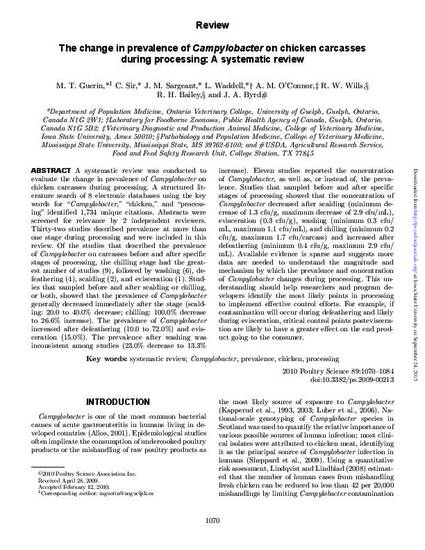
A systematic review was conducted to evaluate the change in prevalence of Campylobacter on chicken carcasses during processing. A structured literature search of 8 electronic databases using the key words for "Campylobacter," "chicken," and "processing" identified 1,734 unique citations. Abstracts were screened for relevance by 2 independent reviewers. Thirty-two studies described prevalence at more than one stage during processing and were included in this review. Of the studies that described the prevalence of Campylobacter on carcasses before and after specific stages of processing, the chilling stage had the greatest number of studies (9), followed by washing (6), defeathering (4), scalding (2), and evisceration (1). Studies that sampled before and after scalding or chilling, or both, showed that the prevalence of Campylobacter generally decreased immediately after the stage (scalding: 20.0 to 40.0% decrease; chilling: 100.0% decrease to 26.6% increase). The prevalence of Campylobacter increased after defeathering (10.0 to 72.0%) and evisceration (15.0%). The prevalence after washing was inconsistent among studies (23.0% decrease to 13.3% increase). Eleven studies reported the concentration of Campylobacter, as well as, or instead of, the prevalence. Studies that sampled before and after specific stages of processing showed that the concentration of Campylobacter decreased after scalding (minimum decrease of 1.3 cfu/g, maximum decrease of 2.9 cfu/mL), evisceration (0.3 cfu/g), washing (minimum 0.3 cfu/mL, maximum 1.1 cfu/mL), and chilling (minimum 0.2 cfu/g, maximum 1.7 cfu/carcass) and increased after defeathering (minimum 0.4 cfu/g, maximum 2.9 cfu/mL). Available evidence is sparse and suggests more data are needed to understand the magnitude and mechanism by which the prevalence and concentration of Campylobacter changes during processing. This understanding should help researchers and program developers identify the most likely points in processing to implement effective control efforts. For example, if contamination will occur during defeathering and likely during evisceration, critical control points postevisceration are likely to have a greater effect on the end product going to the consumer.
Available at: http://works.bepress.com/annette_oconnor/33/

This article is from Poultry ScienceI 89 (2010): 17070, doi:10.3382/ps.2009-00213.